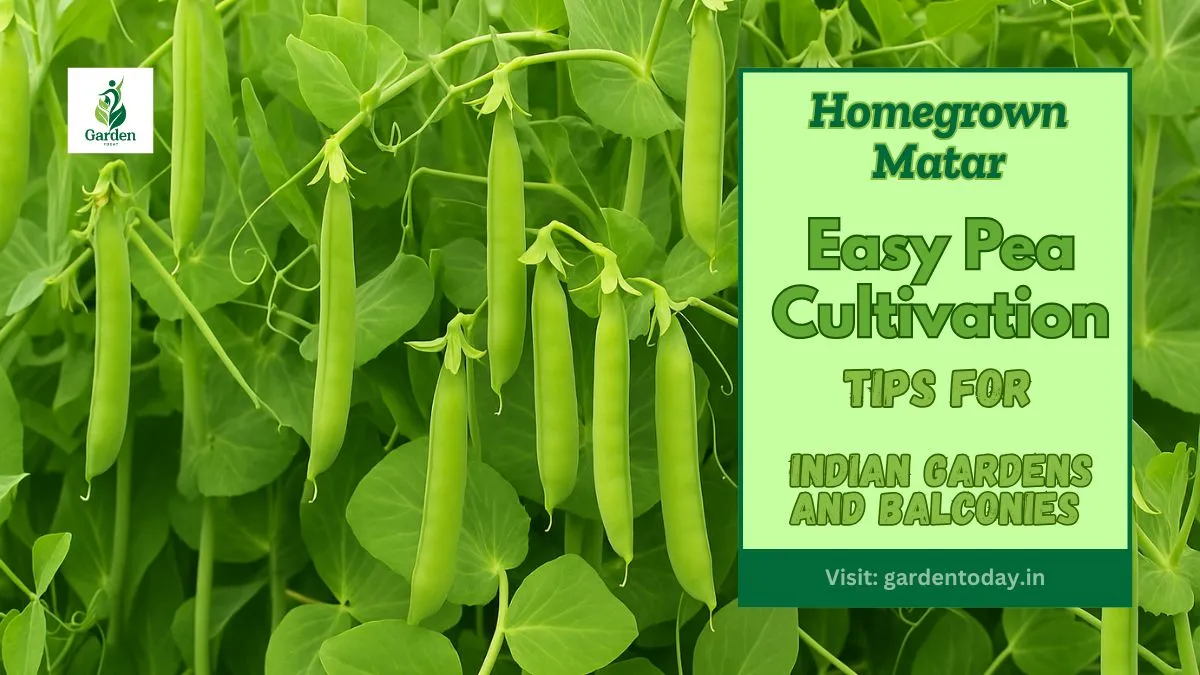Watching green pods being formed on the vines is a wonderful sight for farmers who wish to grow peas at home since it is very captivating and enjoyable. Matar, which is how peas are called in their language, is a cool-season crop cultivated during winters. Shrimadaji claims it is not difficult to cultivate this crop in a garden, which can bring a cherishing feeling when you can harvest sweet peas that can be used in a kitchen garden or on a terrace simply by putting in a little effort and space.
Why Grow Peas?
Dry peas or legumes are one of the easiest vegetables to cultivate, as they don’t require much maintenance or heavy fertilizers. Alongside that, they are a good source of protein and contain minerals and crucial vitamins. Indeed, growing any kind of snow pea, edible-pod or garden pea brings a cherishing feeling when one eats raw matar gathori (freshly harvested peas) from the crop itself.
Best Time to Grow Peas
The Indian Rabi season is a growing season in India where peas are grown best with cool weather. The North Indian region’s pea sowing time spans from mid-October to early December. The South India region, especially the hilly and cooler areas, is the best region to grow peas from October February.
The soil should be easy to work with, not excessively hot—peas prefer to grow at temperatures between 15°C and 25°C. Refrain from planting during the peak summer months, as excessive heat can influence the flowering and pod-setting stages of peas.
How to Start Peas from Seeds
Begin with purchasing high quality and pest-free pea seeds that are appropriate for your area. Seeds of local Indian cultivars like ‘Arkel,’ ‘Pusa Pragati,’ and ‘Bonneville’ are widely accessible online and in local nurseries as well as krishi kendras.
For growing peas, the soil needs to be tilled well alongside incorporating organic compost or gobar khaad (cow dung manure). Good drainage is very important even though peas do not require overly rich soil. The sowing process should be done by placing the seeds approximately 2 inches apart and 1 inch deep and ensuring rows have around 1.5 to 2 feet of spacing. Lastly, the planter pots need to be at least 12 inches deep.
Indoor or Container Growing
Those with limited space can grow peas in a container on a balcony, terrace, or even a windowsill. Simply ensure that one uses a bulky pot or grow bag that has adequate drainage. Place it in a warm spot that receives 4 to 6 hours of sunlight per day. Gradually fill the container with a mixture of compost, garden soil, and sand for aeration.
Try soaking the seeds overnight to increase the chances of quick germination. Make sure to water the soil adequately but gently to set the process in motion.
Support and Care
Climbing pea plants tend to require more support as they mature in comparison to other varieties. In India, the popular method is to build a trellis using retired sari cloth, jute twine or bamboo sticks. You can also use netting or mesh fencing to aid vines in climbing as well as keep the pods clear of dirt.
Make note to frequently water the plant, especially when it is flowering or developing pods. However, overwatering is counterproductive, as it can cause fungal infections like root rot or mildew. If the peas are grown in a region with high humidity, ensure that the plants have proper spacing to foster good airflow.
Flowering and Pod Formation
Peas begin blooming about 30–40 days after sowing. First a white or purple flower develops, followed by a small green pod. The pods are ready to be harvested when they feel full to the touch. The trick is to harvest them regularly in order to boost the number of pods produced.
In most parts of India, harvesting starts after 60-70 days of sowing, depending on the type of crop.
How to Harvest and Store Peas
When harvesting, use both hands: one hand holds the vine while the other hand gently plucks the pod to avoid damaging it; this ensures the rest of the plant will not be damaged. Fresh peas can last in the refrigerator for 3-5 days, while for longer, they can be kept for an extended period after being blanched and frozen.
To blanch, boil the peas for 2 minutes, then transfer them to cold water to stop the cooking process. Thereafter, drain the water, pat dry, and place in zip-lock bags before storing them in the freezer.
Using Peas in Indian Cooking
Peas are commonly found in most Indian households. They appear in famous dishes such as matar paneer, aloo matar, matar pulao, and parathas. Fresh peas add a burst of sweetness and softness to curry and rice dishes. The tender shoots (matar ke patte) can be added to stir-fries or salads and are also incredibly good for you.
Common Pests and How to Deal With Them
Although peas are easy to take care of, some pests and diseases may show up:
- Use local or hybrid varieties for best performance.
- Change the crop type every season to maintain healthy soil.
- Sow every couple of weeks for a steady supply.
- Companion planting with carrots, radishes, and spinach helps maximize the space used.
- Spraying neem oil or soap water will effectively eliminate aphids.
- To prevent fungal diseases, space out your plants and water them early in the day.
- Protect seedlings with nets or shiny tape and CDs.
In India, cultivating peas at home is a wonderful opportunity to relish some organic food while connecting with nature. With just a little input and effort, it is possible to achieve a giant harvest of sweet green matar, which is best during winters. Go get some seeds, find a sunny location, and watch your pea garden expand!
Visit Garden Today
